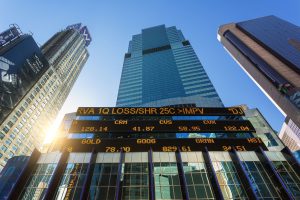Tactical Investor Volatility Index Readings are Soaring
Stock Market Trends: Volatility Index readings have surged to a new high (as shown in the header image above), which means that extreme behaviour in all areas can be expected in and out of the markets. Additionally, we added new psychological data points to the V-Indicator and we suspect that this new high could correspond to a new development in the Coronavirus outbreak. Let’s hope it’s a positive one.
The ETF Trend Portfolio is our most conservative portfolio, so in the light of recent developments, one of which is that V-readings have soared to new highs, we are going to err on the side of caution. This is a dangerous development as over the past 12 months we added a new psychological component to this indicator, and this new high corresponds to the Coronavirus outbreak.

We are not in the “panic” generating business, so there is no need to panic, but this development could mean (operative word being “could”) that China is not telling the full story. The dangerous development is in regards to extreme market volatility; the market could shed several thousand points and then recoup these losses just as fast. Most traders are not prepared for this type of action, so when the market’s pullback strongly or appear to be crashing, they will throw the baby out with the bathwater and in doing so make a colossal mistake.
We are not going to squander time mincing words; instead we are going to provide hard cold facts that will more than clearly broadcast how extremely effective and accurate this service is. Read more about our VIP Futures Service.
China Could be downplaying the situation
In all likelihood, China is releasing selective pieces of data, but in general, the world is used to this. However, what could trigger a sharp reaction from the markets is if this data proves to be damaging. There have been previous scares before and in each case, the markets sold off, but the sell-off proved to be a buying opportunity. The last sell-off was due to the Ebola virus scare back in Oct of 2018.
In the long run, this is not a negative development as the long term trend is still bullish, so if it comes to pass, we will have an opportunity to get into stocks and ETF’s at a discount. We have adjusted pending sell orders, stops and in some cases, cancelled pending orders on the following ETF’s. Bottom line while prudence is warranted, Panic is not; hence focus on the trend and ignore the noise.

Volatility Index readings are high but we are not going to follow the herd
Hence the statement below refers to several dangerous trends but not the ones that come straight to one’s mind:
This is a dangerous development as over the past 12 months we added a new psychological component to this indicator, and this new high corresponds to the Coronavirus outbreak. Interim Market Update Jan 31, 2020
We want to clarify what we mean by dangerous (in the above statement) as we don’t want anyone to falsely assume that we are embracing some of the wild conspiracy theories being put forward regarding this virus. We analysed the data thoroughly, especially the psychological data. We also looked at data evaluated by other level headed experts; many thanks to our subscribers for providing links to some of these experts, which once again solidifies our claim that we are fortunate enough to some have some of the best minds out there as part of our community. We have concluded that the Coronavirus issue is being blown out of proportion.
Weaponised news; A dangerous trend with no end in sight
The first trend is that news is going to be weaponised to the extreme to support whatever narrative a given group of individuals have decided to embrace or force on a subset of the crowd. Secondly, as V-readings have no surged to new highs, the market will experience more random bouts of extreme volatility and this should be embraced when the trend is positive.
Thirdly, violence (as in wars, crime, etc), wild weather patterns will be more prevalent going forward and extreme and we mean extremely stupid behaviour is going to be embraced. Lastly, polarisation levels are going to rise to such an extreme that we could reach a point where a simple disagreement set off something akin to a mini civil war.

Back to the Coronavirus issue:
In Asia, masks are selling out like hotcakes and we suspect many stocks that are in the vaccine creation field have experienced huge price increases. In other words, a group of companies are making out like bandits while the masses being fleeced again. The data out there states that this virus has a mortality rate of 3% and no new data has come out refuting it.
Therefore we find it quite interesting that many financial experts with no background in medicine or psychology have gone out of their way to state that the situation is on the verge of becoming a pandemic. Too many experts believe in the deep state, while there is an apparatus that could be called the “deep state”, their understanding of this topic is limited at best.
The way these power brokers work is to indoctrinate people, so the players are willing participants or blind participants (blind as in being mentally blind and not physically blind) which boil down to the same thing. These individuals are used as cannon fodder; the objective is achieved by pandering to their wild fantasies. This objective is achieved by allowing Gossip artists to masquerade as reporters. In the old days, they would be called fisherwomen.
As of now, we have found no objective data that backs the many claims non-experts are pushing regarding the Coronavirus and the only dangerous trends we see are the ones we have addressed above. Could the situation change? Yes, anything is possible, but history reveals that most naysayers are full of hot air as the world was supposed to have officially ended a long time ago

We had pandemics before so this is nothing new
As I am typing, people are dying all over the world. In the time it took me to type this sentence, more than 15 people died. Seventy-eight thousand people have died today, and the number will rise to 80,000 or more by the time you get this update. So far this year 9,500,000 people have died, and that number rises every second. One could state that death is a pandemic, but no one is screaming about that issue. Smoking-related and or Cancer-related deaths could be also classified as a pandemic as more than 16.6 million will die this year from both, and yet no one makes a big deal (9.6 million from cancer and seven million-plus from smoking).
To date, roughly 2860 people have died from the coronavirus, and suddenly it’s the new Black Death. To be clear, we are not making light of the situation, but so much attention is being given to this one agent when compared to other agents of death. Here is an interesting fact; there are twice as many new births as deaths on a global basis. Live data on world deaths, birth rates, coronavirus deaths, etc. can be obtained from here http://bit.ly/32wVaQA
High Volatility Index Readings: Use This To Your Advantage
There have been more than a dozen outbreaks since 1980 and with far deadlier outcomes in some instances, but if you look at the chart above, after a knee jerk reaction, the markets trended higher. Hence, the Tactical Investor saying; “every disaster leads to a hidden opportunity” and the only way to spot that opportunity is not to give in to panic. We envision a similar outcome for the coronavirus, the markets could still sell-off but that sell-off should be viewed through a bullish lens.
The mass mindset is hard wired to panic. One can overcome this shortfall by observing this behavior impartially and then ask this simple question “why am I doing something that has never led to a positive outcome”. Secondly, as we have advocated for years, one should maintain a trading journal and the best time to put pen to paper or fingers to a keyboard is when the markets are tanking. Make a note of the emotions that are swirling through your mind. Jot down some of the headlines the media is pushing out and observe the reactions from your fellowman. This information will prove to be priceless in the weeks, months, years and decades to come.
The markets are trading in the extremely overbought ranges on the weekly charts, and in theory, they should let out some steam, but the monthly charts, for now, are exerting more upward pressure than they normally do. It should be noted that the weekly charts also move relatively slowly, so there is still time for the markets to let out some steam.
Courtesy of Tactical Investor
What Will The Stock Market Return In 2020?
It’s the most wonderful time of the year — when investment gurus unveil their predictions for what the stock market will return in the coming year.
We expect investment experts to have crystal balls that allow them to see how the stock market is going to perform in the future. Of course, they don’t have crystal balls, and their predictions often aren’t helpful.
The problem with expert predictions of the stock market isn’t that they are wrong — which they often are — the future is uncertain, and we shouldn’t expect anyone to predict it. The problem is that investors often listen to these predictions and base investment decisions on them.
There are better ways to cope with the uncertainty of the 2020 market than listening to predictions. Before we get to those, let’s review what we can predict and what we cannot.
What We Can Predict
While the stock market follows a cycle but defies prediction, history can provide insight into what we might expect from the markets in any given year.
The histogram below displays the dispersion of returns on the S&P 500 since 1928:
As you can see, in about two-thirds of the years, the market is up and about one-third of the time it is down. The distribution is roughly a bell curve with a positive skew and a fat left tail (meaning large negative returns happen more often than a bell curve would predict). Full Story
The Top 15 Stocks to Buy in 2020
Heading into a new year, all investors want to know is what stocks they should be buying.
At the beginning of this year, I attempted to answer that question by compiling a portfolio of the top 15 stocks to buy for 2020. In mid-February, that portfolio of stocks was up a whopping 22% year-to-date.
Then, the novel coronavirus outbreak went global. Russia and Saudi Arabia started an all-out oil price war. Financial markets across the globe fell off a cliff. So did my portfolio of top stocks to buy for 2020.
But, I think now may be as good a time as any to double down on these top stocks. Coronavirus headwinds are fleeting. They will pass. Once they do, these long-term growth stocks will get back to winning.
In no particular order, the top 15 stocks to buy for 2020 in March are:
- Facebook (NASDAQ:FB)
- Activision (NASDAQ:ATVI)
- Luckin Coffee (NYSE:LK)
- Beyond Meat (NASDAQ:BYND)
- Netflix (NASDAQ:NFLX)
- Pinterest (NYSE:PINS)
- Canopy Growth (NYSE:CGC)
- Square (NYSE:SQ)
- The Trade Desk (NASDAQ:TTD)
- Etsy (NASDAQ:ETSY)
- Okta (NASDAQ:OKTA)
- JD.Com (NASDAQ:JD)
- Stitch Fix (NASDAQ:SFIX)
- Nio (NYSE:NIO)
- Snap (NYSE:SNAP)
Without further ado, then, let’s take a look where these top stocks to buy for 2020 are going next. Full Story
20 Predictions for the Stock Market in 2020
t’s a brand-new year, and boy, does 2020 have some big shoes to fill. Last year, we witnessed the benchmark S&P 500 (SNPINDEX:^GSPC) gallop higher by nearly 29%, which is quadruple the historic average annual return of the stock market, inclusive of dividend reinvestment and when adjusted for inflation.
The big question, of course, is what might the current year hold for the broader market and investors? The following 20 predictions for the stock market in 2020 may offer some insight.
1. There will be no recession in 2020
Probably the biggest question on investors’ minds is whether a recession is brewing. While that does look to be the case following a very brief inversion of the two-year and 10-year Treasury bonds in late August, data from Credit Suisse, dating back to 1978, shows that the average recession doesn’t pop up until 22 months after the inversion occurs. Similarly, stock market returns don’t turn negative until an average of 18 months after an inversion, putting the market on track to lose its steam during the first quarter of 2021 (assuming these averages hold true).
For the time being, the longest economic expansion in U.S. history looks poised to continue.
2. The stock market will have another positive year
Despite the stock market delivering returns that were well above the historic norms in 2019, this year should deliver more gains to investors. Full Story
Other Articles of Interest

Bear Market nonsense: Experts want you to think Markets are Going to Crash

US Dollar Finally Hit Bottom?

Uranium Futures price chart

Sophistication in Sentiments: The Stock Market Emotions Chart Explained

The Artful Approach to Winning the Stock Market Game

Harnessing Power: The Dynamic Approach of Small Dogs Of the Dow

Psychology Unveiled: Exploring the Depths of the Human Mind

Stock Portfolio Tracker

What happens if the stock market crashes?

Achieving Financial Goals with Intelligent Investing Strategies

Stock market performance 2019

Quantitative Easing Definition

Stock Market Update




